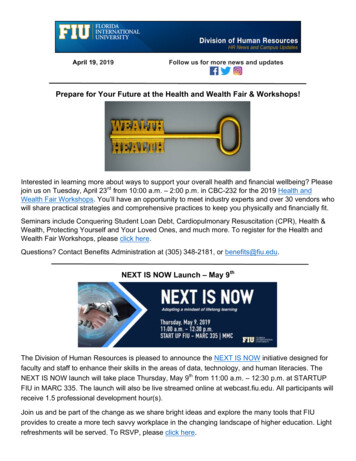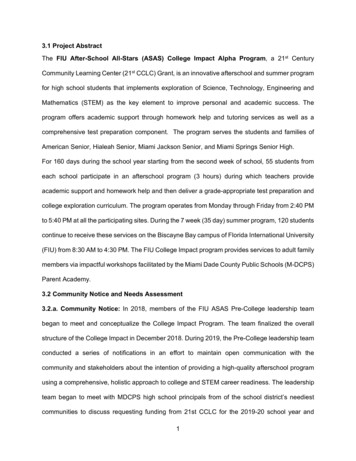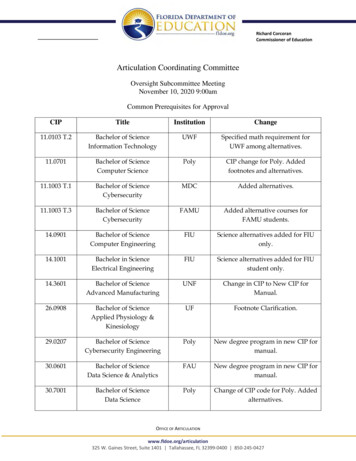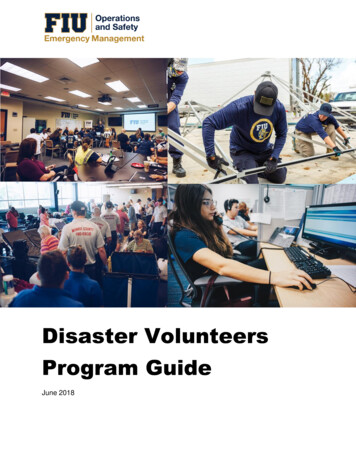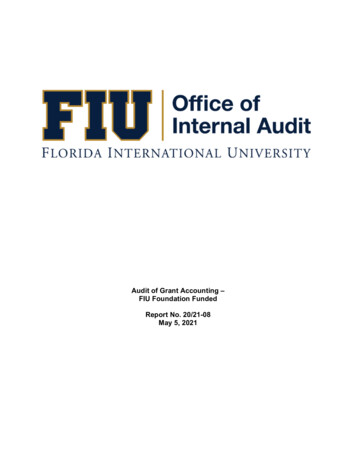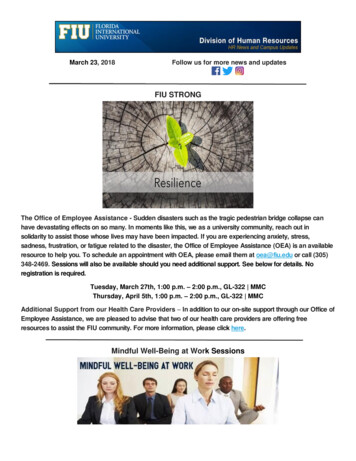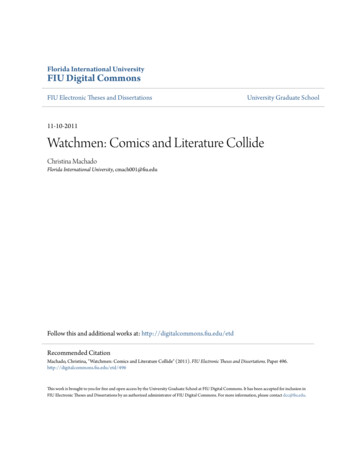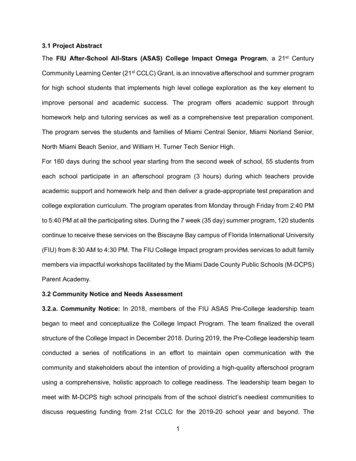
Transcription
3.1 Project AbstractThe FIU After-School All-Stars (ASAS) College Impact Omega Program, a 21st CenturyCommunity Learning Center (21st CCLC) Grant, is an innovative afterschool and summer programfor high school students that implements high level college exploration as the key element toimprove personal and academic success. The program offers academic support throughhomework help and tutoring services as well as a comprehensive test preparation component.The program serves the students and families of Miami Central Senior, Miami Norland Senior,North Miami Beach Senior, and William H. Turner Tech Senior High.For 160 days during the school year starting from the second week of school, 55 students fromeach school participate in an afterschool program (3 hours) during which teachers provideacademic support and homework help and then deliver a grade-appropriate test preparation andcollege exploration curriculum. The program operates from Monday through Friday from 2:40 PMto 5:40 PM at all the participating sites. During the 7 week (35 day) summer program, 120 studentscontinue to receive these services on the Biscayne Bay campus of Florida International University(FIU) from 8:30 AM to 4:30 PM. The FIU College Impact program provides services to adult familymembers via impactful workshops facilitated by the Miami Dade County Public Schools (M-DCPS)Parent Academy.3.2 Community Notice and Needs Assessment3.2.a. Community Notice: In 2018, members of the FIU ASAS Pre-College leadership teambegan to meet and conceptualize the College Impact Program. The team finalized the overallstructure of the College Impact in December 2018. During 2019, the Pre-College leadership teamconducted a series of notifications in an effort to maintain open communication with thecommunity and stakeholders about the intention of providing a high-quality afterschool programusing a comprehensive, holistic approach to college readiness. The leadership team began tomeet with M-DCPS high school principals from of the school district’s neediest communities todiscuss requesting funding from 21st CCLC for the 2019-20 school year and beyond. The1
leadership team also sought input from the two private high schools in the target areas: DadeChristian School and Monsignor Pace High School. The private schools declined participation.Beginning in February, the leadership team conducted needs assessment surveys from eachpotential target school. The leadership team also administered surveys to students, parents, andother stakeholders in the high schools in the area.In early July, FIU-ASAS and the targeted schools utilized the Ed Connect system to call all of thehomes in the feeder patterns to announce the intention to apply for 21st CCLC funds and providea program description. Hard copies of approved 21st CCLC applications will be made availableto each target school site and key stakeholders in the community. Additionally, the application willalso be made available in a pdf file via request through the FIU-ASAS website, which already hasa 21st CCLC page that includes program calendars and links to information on student activities.The IT department, under direction from the Project Director, will update the webpage monthly.3.2.b. Needs Assessment: In 2019, the FIU Pre-College leadership team met with area targetschool administrators, and surveyed students and parents from target areas to determine a needfor the College Impact Omega program. The target school administrators overwhelmingly supportthe College Impact Omega program, and the surveys indicated a dire need for the services. Theleadership team attempted to survey the private schools but they declined to participate. Thesurveys at the target schools revealed that most students hangout by themselves after schooland/or prefer to hang out with friends (42%). Another 39% do some type of entertainment activityafter school. Only 14% indicated they studied or did homework or schoolwork after school.Although 48% of the students surveyed indicated they attend an after-school program, there arevery few academic after-school programs available at the target schools. According to theAfterschool Alliance (2014), the hours of 3:00 PM and 6:00 PM are times when most juvenilecrimes are committed in the target area, so it is concerning that many target school students areidle and unsupervised during this time period.2
As seen in the administrator questionnaires, the administrators indicated that few students in thetarget schools have access to quality PSAT, SAT, or ACT test preparatory programs. Studentsare also in need of tutoring in math, science, and language arts. The administrators noted thatmany students from the target schools would be the first in their families to go to college. Most ofthem have a limited exposure to college and career opportunities. They need help expanding theidea of what success looks like.The school administrators also indicated that the parents are also in need of support. Parents donot have access to sound financial literacy resources that can help their families and prepare theirchildren for college. Parents are also seeking financial aid workshops, first-generation collegeawareness, understanding the college admissions process, career pathways, and otherresources to help support their children. M-DCPS, 5000 Role Models, among other agencies,have been identified as community resources that are aligned with the proposed programservices. The College Impact Omega program will provide the test preparation, tutoring, collegeguidance, and parental educational support services that the target population is yearning for.Demographic Data from the Target Area is Troubling.Table 1 data clearly show that theeducational level of the population in the target area is low when compared to similar populationsboth at the state and national levels. The data show that only 81.0% of the population living inMiami Dade County, age 25 and older have a high school diploma, and only 76.4% of those livingin the target areas have a high school diploma. This compares to roughly 87% of similarpopulations at both the state and national levels. Similarly, only 14.5% of the population in thetarget areas has a bachelor’s degree compared to 30.9% and 28.5% at the national and statelevels respectively. Table 1 also presents a comparison of national, state, county, and city datathat clearly establishes the economic needs of the target area. In all key characteristics, bothMiami Dade County and the target area, on a percentage basis, rank significantly lower than boththe state and national levels.3
Table 1 - Comparison of National, State, County, and City Demographic adeTargetof FloridaCountyAreaPercent of People Below Poverty14.6%15.5%19.0%22.7%Percent of People with Bachelor’s Degree30.9%28.5%27.8%14.5%Percent of Population (25 and older) with 87.3%87.7%81.0%76.4% 50,883 46,338 37,340High School DiplomaMedian Household Income (2013-17) 57,652Source: 2013-17 U.S Census Bureau, American Communities Survey, 5 Year EstimatesAdditional information demonstrating the critical need for academic and enrichment supportactivities at the targeted schools is shown below. A large percentage of students across the fourtarget schools are not demonstrating proficiency in reading and math. All four target schools haveless than a 1000-combined reading and math scores in the SATs. This is significant because toattain Florida’s signature scholarship Bright Futures, a student must have a minimum of 1170combined math and reading scores in the SAT. More importantly, according to the most recentState of Florida University System Admissions Matrix, students who typically gain admissions tothe state universities have combined SAT scores far above 1000. This means many of the targetstudents are not meeting the minimum admissions requirements.All four schools have been identified for Targeted for Support and Improvement (TS&I) under theStudents with Disabilities and English Language Learners subgroups. College Impact Omega willprimarily recruit students who are ‘not proficient’ as determined by their most recent statewideassessment result. As shown in the following table, between 48% and 76% of students are notproficient in English as demonstrated by percent achieving passing scores (3 and above) in theFSA English Language Arts (ELA) exam. The difficulties with achievement are compounded by4
two risk indicators: over 70% of each school population is classified as economicallydisadvantaged, and a majority of the student population are minority students.Table 2 – Target Schools ProfileCharacteristicCentralNorlandN. M. BeachT. TechFree/Reduced Lunch80.3%73.7%71.5%74.7%Minority Rate99%99%97%99%Algebra 1 EOC (Percent in Level 3-5)25%27%23%36%FSA ELA (Percent in Level 3-5)24%26%33%52%SAT Math442478442478SAT Reading451472474498School GradesCCCBYesYesYesTargeted Support & Improvement (TS&I) YesSource: Florida Department of Education (2019)Furthermore, the results of Algebra 1 EOC exam also indicate tremendous deficiencies in mathat the target schools. According to Spring 2019 Assessment results, only 25% of students atMiami Central, 27% at Miami Norland, 23% at North Miami Beach, and 36% at William H. Turnerscored a 3 or above, respectively.College Impact Omega proposes to serve 220 students per day at four (4) high-need, highminority, Title 1 Miami-Dade County schools during the academic year: Miami Central, MiamiNorland, North Miami Beach, and William H. Turner Tech. One hundred and twenty (120) studentsfrom the target schools will participate in a seven (7) week summer program at FIU’s BiscayneBay Campus. Support from the target schools, university and community partners will helpCollege Impact Omega meet the needs of the children and families of the target schools.3.3 Dissemination of Information5
Immediately upon formal notification of the grant award, FIU’s ASAS (ASAS) executive directorwill convene a meeting of appropriate university and school district staff to announce the projectand discuss its goals and objectives. FIU College Impact Omega program staff will schedule andconduct information sessions, meetings, presentations, and discussions widely. The programdirector will meet with representatives from each target school, including principals, assistantprincipals, selected teachers, and counselors to communicate and discuss the goals andobjectives of the FIU College Impact Program and to identify potential students for participation.The program director will develop a descriptive program brochure for dissemination to targetschools, parent teacher associations, community agencies, civic organizations, local churches,selected area businesses and other appropriate organizations and agencies. The programanticipates that community agencies, civic organizations, local churches, businesses, and theCommunity Advisory Board will be especially active and helpful in spreading the word about thishigh impact college exploration program. Other announcements will include press releases inlocal newspapers written and disseminated by FIU’s Office of External Relations. Flyers will beprinted and circulated throughout the community in English, Spanish, and Creole in order toassure widespread attention throughout the communities we aim to serve.Project staff will conduct presentations for interested students and their parents at the targetschools’ Open House events. At these meetings, the goals and objectives of the project will bedescribed and reviewed, and application materials will be distributed. FIU staff will use theCommunity Advisory Board, as well as school district officials, university staff, representatives ofcommunity agencies and ethnic organizations to participate in our recruiting meetings, briefings,and presentations. Further, the project will take full advantage of the already establishedcommunity network being utilized by our resident TRIO and 21st CCLC programs at the university.Finally, the program acknowledges the importance and effectiveness of word-of-mouth as acommunication tool. To that end, we will inform all of our current students who live or have familywithin the targeted school region regarding the project. Our purpose in doing so is not only to seek6
potential participants, but also to ask that all students serve as volunteer ambassadors who willspread the word about the project and its objectives.The College Impact program will work with FIU’s internal website developers to create a websitedescribing the key components of the program, the schools and students being served, and anyinformation related to the project. The site will be maintained by program staff to meet therequirements established by the 21st CCLC grant. The FIU-ASAS website will be updated toreflect the award within 30 days of notification. To engage community stakeholders,announcements including project progress as well as key challenges and successes, will also bemade on our Facebook, Instagram and Twitter accounts which will also be communicated.Utilizing technology, we will establish a regular schedule of email blasts, group texts, and EdConnect messages to parents and/or guardians to disseminate program information.3.4 Target Population, Recruitment and Retention3.4.a. Target Population: Getting at-risk and educationally disadvantaged students to graduatefrom high school and continue their education by enrolling in postsecondary programs has longbeen and continues to be a major goal of the educators at FIU. Project College Impact Omegawill continue this mission by serving 220 high school students grades 9th through 12th from thefollowing four high schools: Miami Central, Miami Norland, North Miami Beach, and William H.Turner Tech. Students from the target schools represent Miami-Dade County’s neediest studentpopulation. The target schools have some of the highest rates in free or reduced lunch, lowestSAT, FSA, and EOC test scores, are situated in high poverty areas, and have the highestpercentage of populations speaking a language other than English. Furthermore, the studentshave limited access to high-end academic enrichment programs. Consequently, many of thestudents in the target schools are limited in their educational aspirations.Recruitment: The College Impact Omega program staff will work closely with the target schools’staff to execute strategies that address the students’ general academic, social, and personalneeds. Staff will conduct presentations, information sessions, classroom presentations, and Open7
Houses to recruit students and parents to College Impact Omega. Marketing materials will bedistributed specifically to target populations which clearly describe the program’s goals andobjectives and intended outcomes to be attained with both students and their parents. Materialswill be distributed in English, Spanish, and Creole through target schools, churches, localcommunity, and current FIU program participants.College Impact Omega will be publicized to all students at each site. In determining the eligibilityfor student participation, the following specific criteria will be used in the selection process: (1)high school students attending four target schools, with priority given to 9th graders and (2)expressed interest in higher education. Special attention will be given to students who meet thefollowing criteria: (1) alumni of the FIU ASAS or FIU EV3 Middle School Robotics Program, (2)needing academic support in math, science, and language arts, (3) low income status, (4) minoritybackgrounds, (5) potential first-generation student in college, and (6) in a TS&I subgroup. SchoolIEPs will be used to deliver accommodations for special needs students on a case-by-case basis.Written applications will be collected by the designated contact person at each target school whowill then forward them to the assistant director at FIU. Nominations of applicants by area privateschools, civic and community agencies, churches, school personnel and others will beencouraged, and application forms will be available for download on the website. Before the finalselection of project participants is made, input on the academic and attitudinal backgrounds ofthe applicant pool will be invited from target school teachers and counselors. Site coordinators,the assistant director, and the program director will make the final selection of students.Retention: Student retention is another key objective of FIU administrators. Thus our successis not solely measured by the number of enrolled students but also by the number of students wekeep (or retain) in our pre-college programs and promote into post-secondary institutions.Student retention can become an issue for the following reasons: (1) uncertain career path/goal,(2) inability to succeed in the classroom, apathy; (3) finding the material irrelevant or too boringto engage in and (4) no support at home. We encourage student retention by engaging them in8
the following ways: (1) providing a goal-driven learning environment, (2) engaging andempowering parents to be involved in their children’s education, (3) providing assistance in thefinancial aid process and in gaining admission to select colleges & universities, (4)delivering comprehensive test preparation, (5) an on-campus summer program that simulatesthe college experience, and (6) offering incentives such as eligibility for the Golden ScholarsSummer Bridge program and for the Invitational Scholars Award, which is only available to FIUpre-college students who continue their education with FIU.3.5 Times and Frequency of Service for Students and Adult Family MembersCollege Impact Omega will serve 220 high school students from the four target schools. Theafterschool program will operate Monday through Friday, 3 hours a day, from 2:40 PM to 5:40 PMfor a total of 15 hours per week. The program will not operate on early release days but will runfor 160 days throughout the school year. The summer program will operate at the FIU BiscayneBay Campus will host 120 students from 8:30 AM to 4:30 PM (40 hours/week) for 35 days.College Impact program will provide services to adult family members via workshops facilitatedby the M-DCPS Parent Academy. The goal of the Parent Academy workshops is to provideparents and guardians of participating students with resources that will enhance their child’sacademic success. Some of the topics include Program Overview, Mindfulness, Depression,Financial Aid, Financial Workshop, and Summer Learning Loss. Our meetings will be 2 hours longoffered at variable times throughout the year. A minimum of six activities will be offered throughoutthe academic year. The required site profile worksheets will provide details as well as the sampleschedule for the afterschool, summer, and adult family member educational components.3.6 Evaluation Plan and DesignIndependent Evaluator: The proposed program director has identified an independent externalevaluator who possesses all the following qualifications and experience: (a) more than 30 yearsof experience in educational program evaluation, almost all of which involve federal programsincluding 21st CCLC projects, (b) demonstrated knowledge, skills, and abilities in evaluation9
planning design, instrumentation and survey development and management, and quantitative andqualitative analytical and reasoning skills (including parametric and nonparametric statisticalskills), (c) experience working with programs that focus on low-income, urban, minority, firstgeneration students, and (d) excellent oral and written communication skills. The program directorwill comply with all university procurement processes in the final selection of an evaluator.Evaluation Activities: The evaluation will include, but not be limited to, collecting participants’academic performance data (i.e., ELA, math, science report card grades) on a quarterly basiseach academic year. Other empirical participant data (e.g., SAT scores, attendance data,disciplinary data, etc.) will also be collected at mid-year and end-of-year, as appropriate. Inaddition, project-developed survey instruments will be administered each year to programstakeholders (i.e., participants, staff, and parents) at three points: pre-program (baseline - Fall),mid-year (progress – Winter), and post-program (summative - Spring). Individual and small groupinterviews will also be conducted with selected participants and staff during the Fall and Springterms of each program year.Preliminary Areas of Inquiry: The preliminary areas of inquiry for the survey and interviewinstruments are expected to include, but not be limited to, the following: Students: (a) criticalthinking, problem-solving, decision-making skills, and research/analytical skills, (b) social andinterpersonal and communication skills/behaviors, (c) self-disciplinary attitudes and behaviors, (d)attitude towards school, participation in class, homework completion, and motivation to do well inschool, graduate from high school, attend college or enter the workforce, and (e) curiosity aboutcollege, awareness of college and career/workforce requirements, and thinking about future plansfor college/career. Staff: similar in nature to the areas above for students, but from the staff’sperspective about students. Parents: similar in nature to the areas above for students, but fromthe parents’ perspective about their children. Also, parents’ familiarity with program goals andobjectives, their own literacy and numeracy knowledge and skills (e.g., oral/writtencommunication, technology, financial), their knowledge of health and nutrition issues, their10
participation in educationally-related activities (e.g., helping with homework), their involvement intheir children’s education (e.g., Back-to-School Night, parent-teacher conferences).Accurate Data Collection, Analysis, and Reporting: In all efforts concerning data collection,analysis, and reporting, care will be taken to ensure the privacy of stakeholder identities and data.In order to promote stakeholder cooperation and participation and to increase the potential forvalid data, in addition to statements regarding confidentiality, each survey/interview instrumentwill describe the purpose of the data collection effort and importance of collecting accurate data.Random validity screening of all data collected will be conducted to ensure data quality. Surveydata will be collected using the university’s Qualtrics system, and all quantitative data will becompiled and analyzed by the evaluator using appropriate statistical software. Stakeholdersurveys developed and administered by the Florida Department of Education will also be analyzedby the evaluator and will factor into the overall evaluation effort. All draft reports submitted by theevaluator will be screened by the program director before being finalized for dissemination.Coordination of Evaluation Activities: The evaluator will prepare annual comprehensive evaluationmanagement plans for program staff, outlining the evaluation objectives, activities,responsibilities, and instructions and timelines for instrument distribution, administration, andcollection. As practical, at the beginning of each program year, the evaluator and program directorwill meet with key staff, and the program’s Community Advisory Board to review the managementplan and instrumentation to ensure maximum coordination.Examining Program Impact: Performance data (i.e., report card grades) will measure the extentto which participants’ academic performance has been maintained at satisfactory levels,increased or improved, or decreased or declined. Other performance data (e.g., attendance,disciplinary data) will measure possible trends and the extent to which such performances haveremained stable, increased, or decreased. Using Likert and other similar rating-type scales,stakeholder survey data will measure various aspects of the program (e.g., perceptions of: [a]participants’ knowledge, skills, attitudes, etc., [b] progress toward achievement of program11
objectives, [c] program impact, [d] stakeholder satisfaction with program services and activities,etc.). Qualitative data from open-ended survey questions and interviews will help to clarify andexplain the quantitative data. The processes for ensuring data accuracy and evaluationcoordination described immediately above are expected to ensure data integrity and consequentlyenhance the potential for valid analyses of program impact.Reporting and Use of Evaluation Data: In addition to monthly oral reports to the program director,each year the evaluator will prepare a minimum of two written reports: a mid-year progress reportand an end-of-year final report in which all quantitative and qualitative data collected will bepresented, discussed, and summarized. After reviews by the program director, the reports (eitherin their entirety or appropriate excerpts thereof) will be disseminated through appropriatecommunication channels to all stakeholders, including but not limited to: appropriate Universityadministrators and program staff, target school district and school administrators and staff, theprogram’s Community Advisory Board. Periodic press releases may also be prepared for localcommunity consumption. At the program director’s discretion, meetings will be convened withselected stakeholders to review the findings of the evaluation reports, discuss the impact of theprogram and progress toward the achievement of the long-term goals and short-term objectives,and make plans for the implementation changes to program services and activities, timelines, orother program-related variables.3.6.a Statewide Standard ObjectivesAs indicated in the RFP, the information for this section is located in the objectives table.3.6.b Objectives for Academic BenchmarksAs indicated in the RFP, the information for this section is located in the objectives table.3.6.a Applicant-Specified ObjectivesAs indicated in the RFP, the information for this section is located in the objectives table.3.7 Approved Program ActivitiesAcademic Year12
FIU College Impact Omega will consist of the following approved program activities: academicenrichment with a 10:1 student-to-teacher ratio; mentoring; and tutoring services that align withthe state and local academic standards. These activities are designed to help students improvetheir academic performance and increase their college admissibility. The after-school classroomactivities during the 2019-2020 school year, five days a week, on regular school days as listed onthe official M-DCPS 2019-2020 School Calendar for Elementary and Secondary Schools. Theseactivities will take place at the respective schools under the supervision of the site coordinatorsand led by certified teachers. College Impact activities are classified under five areas that addressthe seven program objectives. The five areas are Test Prep, Tutoring, College/Career Readiness,Personal Leadership, and Parent Academy. Classroom activities will be provided for a total of 160days during the regular school year.All program activities will utilize a wide range of strategies to support the different learning stylesof students. In the first week of the program, students will be assessed to determine their learningstyles. Program administrators will work with key day school department heads to ensure activitiessupport the regular school day curriculum. The majority of target school students surveyedindicated that they would be willing to attend a program focus on exploring different jobs andcareers and preparing them for college. This dynamic program offers a variety of activitiesincluding high-quality test preparation, field trips, college tours, in-depth college and careerexploration, and personalized staff attention that encourage student attendance.Table 4: After School Program ActivitiesObjective DomainActivities1. English Language ArtsTestNeeds AssessmentPrep/ LowTutoring2. MathematicsTestELA&SATDurationVerbal 2 HoursScoresPrep Low Algebra 1 EOC & SAT 2 Hours/TutoringMath Scores13
3. ScienceTestPrep Low/Tutoring4a. Algebra 1 EOCTestFDOEScience 2 HoursAssessment ScoresPrep Low Algebra 1 EOC2 Hours/Tutoring4b. High School GraduationAll ActivitiesLow Educational Attainment in 10 HoursTarget Area5. Socioemotional Learning6. College/Career Readiness7. Adult Family Educationper weekPersonalLow-Income, First-Generation 2 HoursLeadershipPotential College StudentCollege/CareerLow Educational Attainment in 2 HoursReadinessTarget AreaParentLow Educational Attainment in 2 HoursAcademyTarget AreaTest Prep: The PSAT, SAT, and ACT exams play a critical role in the college admissions processand students’ ability to earn scholarships like Bright Futures. This program activity is designed tohelp students prepare for the rigors of taking of the PSAT, SAT, and/or ACT. The test prep willfocus on the mastery of Math, Science, and English as well as proven test-taking strategies.Certified teachers trained in college test prep will lead the test prep activities.Tutoring: The high school grade point average or G.P.A. is also a major factor in the collegeadmissions process and access to merit-based scholarships. The tutoring activities help studentslearn, review content, explain how to solve problems, and check completed work. Students willalso learn how to develop successful study techniques that will help them flourish academically.Certified teachers will facilitate the tutoring activities.College/Career Readiness: This high touch activity is a comprehensive, engaging approach tothe college admissions process and career exploration. Students will explore a variety of topicsrelating to college and career readiness including admission requirements, different types of14
schools, financial aid, careers, and other important topics. Students will also be given theopportunity to research c
(FIU) from 8:30 AM to 4:30 PM. The FIU College Impact program provides services to adult family members via impactful workshops facilitated by the Miami Dade County Public School s (M-DCPS) Parent Academy. 3.2 Community Notice and Needs Assessment . 3.2.a. Community Notice: In 2018, members of the FIU ASAS Pre-College leadership team


